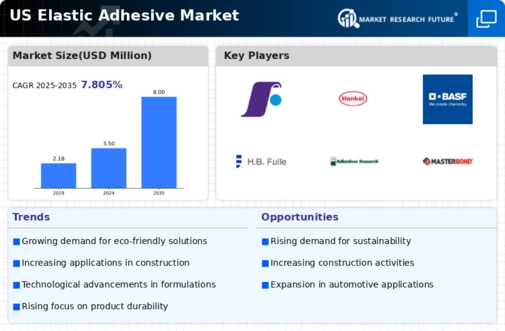Growing Construction Activities
The elastic adhesive market is experiencing a notable boost due to the increasing construction activities across the United States. With the construction sector projected to grow at a CAGR of approximately 5% from 2025 to 2030, the demand for high-performance adhesives is likely to rise. Elastic adhesives are favored for their flexibility and durability, making them ideal for various applications, including flooring, roofing, and wall coverings. As construction projects become more complex, the need for reliable bonding solutions that can withstand environmental stresses is paramount. This trend indicates a robust growth trajectory for the elastic adhesive market, as builders and contractors seek materials that enhance structural integrity while providing ease of application. Furthermore, the push for energy-efficient buildings may further drive the adoption of advanced adhesive technologies, thereby expanding the market's potential.
Expansion of Automotive Applications
The automotive sector is a pivotal driver for the elastic adhesive market, as manufacturers increasingly utilize these adhesives for various applications, including body assembly, interior components, and exterior trims. The U.S. automotive industry is projected to grow steadily, with an expected increase in vehicle production and sales. Elastic adhesives offer advantages such as weight reduction, improved fuel efficiency, and enhanced safety features, making them attractive to automotive manufacturers. As the industry shifts towards electric vehicles, the need for lightweight materials and efficient bonding solutions is likely to propel the demand for elastic adhesives. This trend indicates a promising outlook for the elastic adhesive market, as automotive companies seek innovative solutions to meet regulatory standards and consumer expectations.
Increased Focus on Product Innovation
Innovation within the elastic adhesive market is a critical driver, as manufacturers strive to develop products that meet evolving consumer needs. The market is witnessing a surge in research and development activities aimed at enhancing adhesive performance, such as improved bonding strength, faster curing times, and resistance to extreme temperatures. For instance, the introduction of solvent-free and low-VOC formulations aligns with the growing demand for environmentally friendly products. This focus on innovation not only caters to the construction and automotive sectors but also opens avenues in niche markets such as electronics and medical devices. As companies invest in advanced technologies, the elastic adhesive market is likely to see a diversification of product offerings, which could lead to increased market share and profitability for key players.
Rising Demand from the Packaging Industry
The packaging industry is emerging as a significant driver for the elastic adhesive market, particularly in the context of flexible packaging solutions. With the U.S. packaging market projected to reach approximately $200 billion by 2026, the demand for adhesives that provide strong, flexible bonds is likely to increase. Elastic adhesives are particularly suited for applications in food and beverage packaging, where they ensure product integrity and shelf life. The shift towards sustainable packaging solutions is also influencing the market, as manufacturers seek adhesives that are not only effective but also environmentally responsible. This trend suggests that the elastic adhesive market could see substantial growth as packaging companies prioritize performance and sustainability in their adhesive choices.
Regulatory Compliance and Safety Standards
Regulatory compliance and safety standards are increasingly influencing the elastic adhesive market, as manufacturers must adhere to stringent guidelines regarding product formulations and performance. In the U.S., agencies such as the Environmental Protection Agency (EPA) and the Occupational Safety and Health Administration (OSHA) impose regulations that affect the types of adhesives that can be used in various applications. This regulatory landscape encourages manufacturers to develop safer, low-emission products that meet compliance requirements. As a result, the elastic adhesive market is likely to see a shift towards more sustainable and health-conscious formulations. Companies that proactively adapt to these regulations may gain a competitive edge, positioning themselves favorably in a market that is becoming increasingly focused on safety and environmental responsibility.

















Leave a Comment